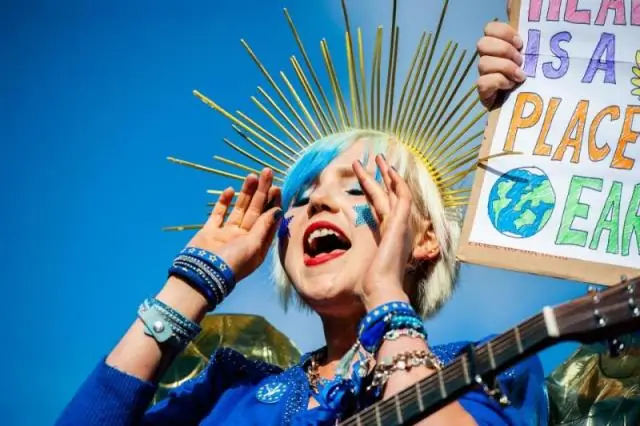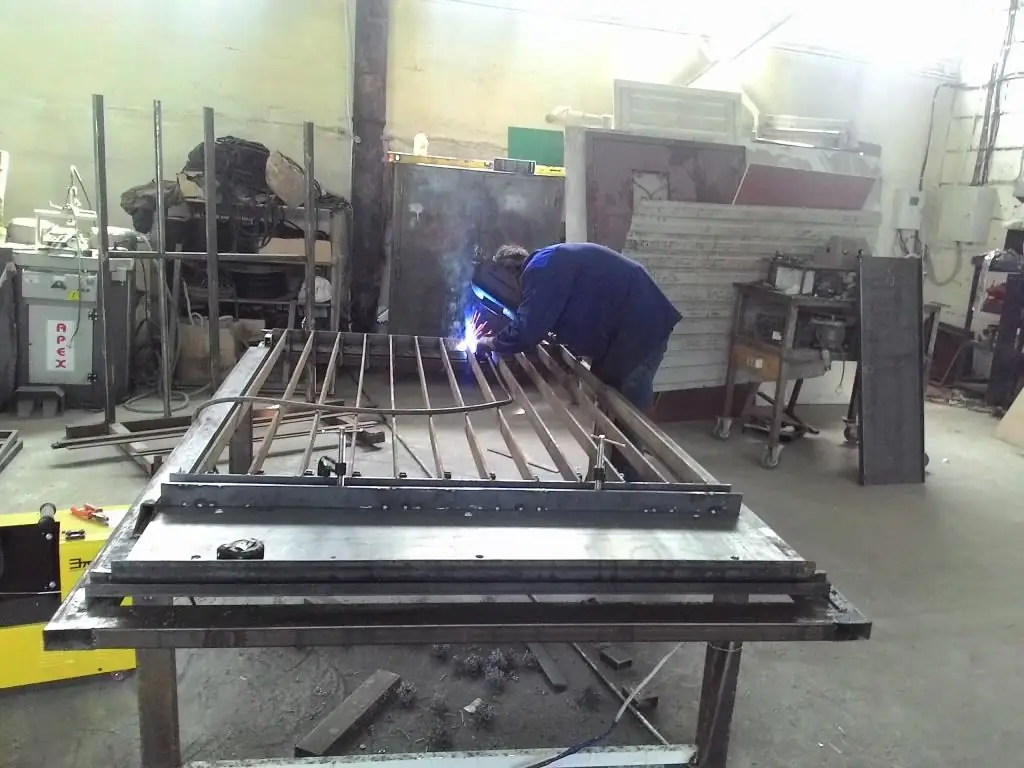
Table of contents:
- How to build a gate from corrugated board with your own hands
- Metal profile for fences and gates - pros and cons
- Preparation for the start of work: drawings and dimensions of the frame
- The choice of corrugated board: advice to masters
- Making a wicket from corrugated board with your own hands
- Tips for finishing and maintaining the gate
- Author Bailey Albertson [email protected].
- Public 2024-01-17 22:26.
- Last modified 2025-06-01 07:32.
How to build a gate from corrugated board with your own hands

If there is a reliable metal profile fence around the house, then the question of what to make the gate from is decided by itself. Installing a wicket door in the opening of an existing fence is quite simple if you know how to work with a welding machine and other installation tools. It is very important that the gate is lightweight, reliable and resistant to atmospheric precipitation. And the metal profile fully meets these characteristics.
Content
-
1 Metal profile for fences and gates - pros and cons
1.1 Gallery of fences made from corrugated board
- 2 Preparation for the start of work: drawings and dimensions of the frame
- 3 The choice of corrugated board: advice to masters
-
4 Making a wicket from corrugated board with your own hands
- 4.1 List of materials and tools
-
4.2 Stages of manufacturing a swing gate
4.2.1 Video: how to install a gate from a metal profile with your own hands
-
5 Tips for finishing and maintaining the gate
- 5.1 Video: how to embed a lock into a gate
-
5.2 Setting the doorbell to the gate
- 5.2.1 Setting the ringer
- 5.2.2 Installation steps
- 5.2.3 Video: how to protect the wireless call button from vandals
Metal profile for fences and gates - pros and cons
Decking is one of the most demanded materials for the construction of wickets and other enclosing structures.

For the manufacture of a wicket, you can use wall corrugated board, which differs from the roofing by a lower wave height and a lower price
The main advantages of the material
- Resistant to external factors and corrosion. Profile sheets are covered with modern polymeric materials that can withstand intense exposure to ultraviolet rays, moisture and temperature extremes.
- Ease and simplicity of installation. A gate from a metal profile can be made in one day, having the skills to work with a welding machine. Its production does not require the creation of complex drawings and diagrams.
- Attractive appearance and wide range of colors. It is easy to match the covering of the gate to match the fence, gates or finishing materials of the house.
- Long service life. The corrugated board structure will last over 50 years.
- Affordable price compared to other cladding materials.
- The possibility of building fences of any height, since the maximum length of the profiled sheet is 12 meters.
- Excellent performance characteristics. The metal profile does not need painting and repair. You can wash it with plain water from a hose.
disadvantages
- Low degree of sound insulation.
- Small sheet thickness. The corrugated board can be easily cut with an ax, deformed with a strong impact and even bent by hand.
- Even small scratches lead to rust on the surface of the material.
Therefore, when making a choice in favor of corrugated board, it is necessary to take into account all the pros and cons of this material.

The sheet of wall corrugated board is covered with zinc and decorative anti-corrosion varnish
Many experts recommend making additional fastening: frequent lathing of the wicket, strengthening the structure with metal sheets, wooden boards or other more durable building materials
Gallery of fences made of corrugated board
-

Fence made of corrugated board - A fence, a gate and a wicket made of corrugated board, made in the same style, create a reliable and beautiful fence
-

Fence made of corrugated board on a concrete base - A fence installed on a concrete base will last much longer
-

Fence made of corrugated board with imitation of brickwork -
Decorative covering of corrugated board is not only monochromatic
-

Decorative fence made of corrugated board - The corrugated board can be supplemented with decorative elements so that the fence from a distance will resemble a massive concrete fence
-

Fence on brick supports - Fence posts made of corrugated board can be made of metal profiles, concrete or brick
-

Wicket and gates from corrugated board - A wicket made of corrugated board is often decorated with forged elements.
-

Fence with imitation stone -
With the help of wall sheeting, you can imitate not only brick, but also natural stone
Preparation for the start of work: drawings and dimensions of the frame
The standard width of a swing gate is 1 meter. With such dimensions, it will be possible to easily bring garden, upholstered and cabinet furniture, as well as other large items to the site. If the width of the structure is greater, then this can lead to rapid wear and tear of the hinges and, as a consequence, deformation of the wicket.
The height of the wicket should not be more than 2-2.2 m. If the fence is higher than these parameters, then the low wicket will not look very aesthetically pleasing. Therefore, in the opening between the posts above the structure of the wicket, you can install metal lintels with an insert from a piece of metal profile.
But if people more than 2 meters in height live in the house, then you will have to install a wicket of greater height with reinforced hinges, and reinforce the frame with additional transverse metal slats
The wicket can be made without the upper crossbar, which will greatly simplify the task and solve the problem with the height of the structure.

A standard corrugated wicket door is installed on a concrete foundation, buried below the level of soil freezing, and has a height of 2 meters
The choice of corrugated board: advice to masters
A good profiled sheet should not only be galvanized on both sides, but also have polymer protection at least on the front surface. For the device of the wicket, you can choose a material with an imitation of stone or brickwork, as well as with a pattern of natural wood.

A fence made of corrugated board under a tree looks like it is made of lining, and has been serving for more than 50 years
Profiled sheeting marking:
- "N" (bearing) - used for roofing;
- "C" (wall) - designed for fences and small buildings;
-
"NS" (universal) - for all types of structures.

Profiled sheeting marking For the device of the wicket, you can choose a simpler and, as a result, cheaper wall penetration
For the device of the wicket, material marked "C" or "HC" is suitable. The numbers after the letter designation indicate the height of the profile wave. For facing wickets, sheets C20 and C21 are recommended.

Profile sheet C21 belongs to the category of wall materials and has a wave height of 21 mm
The metal profile is made of rolled steel, so it can have different lengths. For mounting the structure, the sheet can be used both in length and in width. When buying a profile, take into account the thickness of the sheet. It is not worth making a gate from too heavy material, as it will create a large load on the hinges, but too thin will not work either. A sheet with a thickness of 0.45-0.5 mm will be optimal. A 0.4 mm profile is considered a budget option.
The height of the corrugation is an important indicator of the strength of the material for the device of the gate and other enclosing structures. For facing wickets, it is recommended to use a profile with a wave step of no more than 21 mm.

In the simplest case, the labeling of the sheet consists of the designation of its type, wave height and sheet width
When marking on the sheet, the parameters are indicated in the following sequence:
- profile height;
- sheet thickness;
- sheet width;
- profile length.
Decking can be coated with powder paint or polymer. The second method guarantees the durability of the coating and the color saturation. The sheet can be coated on one side only or on both sides, which provides a more attractive appearance. Colored polymers come in about 30 different palettes.
Making a wicket from corrugated board with your own hands
Since we will weld the wicket to the existing supports, we will not have to concrete the posts, which will greatly facilitate and speed up the work.
List of materials and tools
To install a wicket from corrugated board, a minimum of materials and only the most necessary tools are required:
- metal profile - sheet C21-1150 with galvanized or polymer coating - working width 1 meter, length 2 or 2.2 meters;
- metal square pipe - section 40x24 mm;
- two metal door hinges (polymer can be used) - ɸ30 mm;
- bolt and mortise street lock.
- gas or electric welding;
- Bulgarian;
- cutting and grinding wheel for metal;
- screwdriver and powerful drill;
- rivet gun;
- paint and brushes;
- plumb line or building level, tape measure 5 meters;
- building corner;
- set of screwdrivers.
Stages of manufacturing a swing gate
We present a method for constructing a swing gate made of metal pipes and sheathing made of metal profiles directly on the support posts.
-
First, we mark the place where we will install the wicket and make an opening in the fence of a certain width between two metal supports. In the future, we will weld pipes to them, which will form the frame of the gate. Choosing such a scheme, we will initially be sure that the finished wicket will fit exactly in all respects. Then the problems that arise when welding the wicket in another place will not appear.

Welding the gate frame When manufacturing the frame of the wicket door on site, it is possible to exclude errors related to the discrepancy between its dimensions and the dimensions of the opening in the fence
-
We weld the preliminary frame of the fence in accordance with the measurements. The distance between the supports must be more than 1 meter in order to obtain a 1x2 meter gate. In order to avoid deformation and roll of the frame, we weld it to the support posts in several places.

Fastening the wicket frame The fabricated frame is welded with temporary clamps
-
We weld the upper part of the hinges to the vertical frame of the frame. This is necessary in order to see at what level they should be.

Installing the top of the hinges The upper parts of the hinges are welded to the frame of the wicket, and the locations of the counterparts are marked on the supports
-
To strengthen the structure of pipes, we mount a cross member from the same square pipe in the middle. All angles must be 90 °.

Installing the crossbar A horizontal lintel made of a metal profile serves to strengthen the frame of the wicket
-
We check them using a corner or level.

Final fixing of the crossbar When welding the second end of the crossbar, the horizontal position of its installation is checked
-
After we made sure that the frame turned out to be even and correct, we cut it off at the welding points and put it on a flat surface.

Dismantling the frame After preliminary operations, the frame is cut off and placed on the ground.
-
We cut off all the extra pieces with a grinder and once again re-boil all the seams.

Frame processing All joints are cleaned of excess metal and then finally boiled
-
Then, using a grinder and a grinding wheel, we clean the joints.

Cleaning seams Welded seams are cleaned with a grinder with a grinding wheel
-
After that, we clean the attachment points by welding the lower hinge elements on the supports themselves in order to remove the rust.

Preparation of a place for hinges on supports Places for hinges on supports are thoroughly cleaned from rust
- We weld the lower element of the upper hinge, then we hang the frame and already in place we weld the second part of the hinge from above. If the frame of the wicket is welded correctly, then it will open and close freely and easily.
- We remove the gate and weld on the hinges more carefully, and then we clean all the seams. During welding, it is necessary to underlay an asbestos sheet or ordinary cardboard so that sparks and scale do not fall on the corrugated board of the fence.
-
We mark the place for the mortise lock on the frame of the gate according to the drawing and cut it out with a grinder. The lock and handles are installed at a height of 80-90 cm from the ground.

Castle insert A hole of the required size is cut in the frame of the gate, into which the lock is installed
-
We cut out the holes and fasten the counter bar of the lock using a screwdriver. We check the operation of the lock, the ease of opening and closing the wicket. Then we paint the structure with protective anti-corrosion paint.

Mounting the lock striker The strike plate of the lock is screwed to the support with a screwdriver
-
We take the corrugated board, previously cut to size, and use a drill and a rivet gun to attach it to the frame of the gate. Roofing screws can be used as an alternative.

Fastening the corrugated board to the frame Decking can be fixed with rivets or roofing screws
- If it is planned to install a patch lock, which will be located on the inner side of the wicket frame, we place the fastening holes for it on the transverse crossbar of the frame. We drill holes in the profiled sheet using the "contour drilling" method, and then additionally process them with a cutter. To fix the lock in the cross member of the structure and the plate welded to it, using a drill with a drill and a special tap, we make a threaded hole for installing the screw.
- We install decorative overlays with handles on the lock.
- We make a limiter for the wicket. To do this, we install a metal blank inside the opening, which we cut off from the pipe.
You can assemble such a gate with the help of a partner within a few hours.
Video: how to install a gate from a metal profile with your own hands
Tips for finishing and maintaining the gate
- There is no need to paint the metal profile. We will paint only the frame of the gate with a special protective paint, as well as all welding places, without missing the support pillars. This is necessary in order for the frame to serve for a long time and not to corrode.
- The corrugated board must be regularly cleaned of dirt and dust by pouring water over it from a hose and wiping it with a car sponge or rag. Do not use aggressive chemicals and solvents, as they can destroy the protective layer of the sheet.
- We use ordinary machine oil or grease as a lubricant for the lock and hinges. It is necessary to lubricate the lock and hinges frequently so that they do not corrode, rub or wedge them.
- It is best to choose a double-sided profiled sheet for the wicket, as it will make it more durable and beautiful. Such material resists corrosion and moisture better than one-sided material.
-
It is best to choose a narrow-profile lock for an outdoor swing gate, which is specially designed for installation on square or rectangular pipes. Such locks have good protection against dust, rainwater and melted snow.

Narrow profile lock Narrow profile lock specially designed for installation on rectangular pipes
- If over time the metal profile is damaged or loses its attractiveness, then it can be removed from the frame and installed a new one.
Video: how to embed a lock into a gate
Installing a bell on the gate
The bell, which will run on batteries or accumulators, is the most reliable and convenient to use. Also, such calls can work from a stationary radio receiver. On average, the distance from the gate to the bell is about 130 meters. The main part of the device is installed inside the house on the wall.

The wireless bell consists of two parts, one of which is installed on the gate, and the other in the house
The receiver works from a 220 V network or on batteries. When choosing a call, you need to take into account such nuances as:
- the presence of different melodies;
- aesthetic appearance;
- good lighting;
- additional fasteners (not counting the Velcro);
- bell weight (it must be up to 50 g);
- compliance with the manufacturer's declared operating temperature;
- protection from UV rays, frost, snow and rain.
Before buying, you need to check that the range of the call corresponds to the distance between the gate and the house. It makes no sense to take a powerful device with a range of 150 meters if the house is located 50 meters from the gate, but a weak device of 20 meters in this case will not work either. Wireless calls usually have a mute feature which will be useful at night. The street bell housing must be durable, compact and sealed.

a wireless call requires only a 220 V connection, however, there are battery-powered models that you just need to install and fix on the wall
Calls that are made to operate in areas with maximum cold temperatures are equipped with anti-freeze batteries. The best option would be if the outdoor button can operate in the range from -20 to +35 ° C, and the receiver itself can operate from 0 to +35 ° C.
Ring setting
When installing a bell on the gate, keep in mind that the range, which was declared by the manufacturer, implies an open area without obstacles. In the presence of intermediate structures, the reception radius will be significantly reduced. Therefore, it is necessary to choose points between which there are no concrete and metal structures.

The wicket doorbell will work at the maximum range if there are no barriers between the house and the gate
The radius of the call is significantly reduced if the equipment of GSM networks is nearby
In quantitative terms, the reception area decreases:
- by 10-20% for gypsum and wooden structures;
- by 25-40% for brick walls;
- by 40-85% for reinforced concrete products.
Modern wireless calls are often equipped with additional signal repeaters to increase the range.
Installation steps
- We choose the optimal place for installing the button: under the visor of the support pillar, on the side of the metal profile frame bar, etc.
- If the bell has double-sided tape on the back of the case, you can simply remove the protective film and press the case against the marked installation point. Before that, the surface must be well degreased with a special solution.
- If you don't trust the tape, you can attach the case with self-tapping screws. Usually, special holes are provided in it. If they will be made in corrugated board, then they must be treated with an anti-corrosion compound.
- To fasten the bell to the metal profile, we use special self-tapping screws of a special shape, made of galvanized steel. After fixing the case, we carefully treat all places with screws and a cloth with a sealant. Since the profiled sheet is a multi-layer product with protective layers, any "intrusion" into them can lead to the appearance of premature corrosion.
- On a battery call, you will sometimes need to change the battery. To do this, you need to remove the case and replace the power supply.
- We install the base station inside the house above the front door or in another convenient place. The stationary receiver is simply fixed on the wall by hanging it on a nail. Hang up the network receivers next to the outlet. The most expensive call models are equipped with finger-type or rechargeable batteries with a long service life.
Video: how to protect the wireless call button from vandals
It is quite simple to make a gate from corrugated board, so it can be easily assembled with your own hands, without resorting to the help of masters. Using a minimum of materials and the necessary tools, you can make a gate for the fence and gates of your house in one day. It will serve you long enough if it is not subjected to strong mechanical and physical stress. This is especially true of the profile sheet itself, since it is the most vulnerable link in this design.
Recommended:
How To Make A Veranda With Your Own Hands To The House - Instructions, Projects, Drawings, Photos And Videos

The article describes how to build a veranda close to the house with your own hands
Making A Buleryan (breneran) Stove With Your Own Hands: Advantages And Disadvantages Of The Design, A Device With Drawings, Instructions With A Video, Etc

Design and principle of operation of the "Buleryan" furnace (breran). DIY recommendations with instructions and drawings. Maintenance and operation
How To Make A Chimney From A Steel Pipe With Your Own Hands: Device, Installation Of A Sandwich Structure, Instructions With Photos And Videos

What is a steel pipe chimney, where is it used, its advantages, disadvantages and its manufacture by hand
DIY Fence Made Of Corrugated Board, Installation Of A Fence Made Of Corrugated Board

A fence made of corrugated board with your own hands on a personal plot. Step by step instructions on how to install a fence made of corrugated board with two types of pillars
Making Metal Doors With Your Own Hands: Technology, Drawings, Equipment, As Well As How To Make Heat And Noise Insulation Correctly

Metal door manufacturing technology. Tools and equipment for self-production of metal doors. Warming and finishing
